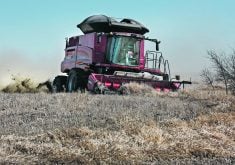Using nutrient management as a strategy for crop enrichment can help farmers gain more dollars.
“Farmers can get more bang for their buck when applying manure to their fields if they think strategically about which fields or crops can benefit the most from manure application,” said Trevor Wallace, nutrient management specialist with Alberta Agriculture.
“It’s sometimes thought of as just an environmentally friendly means of disposal rather than a way to enrich the soil and increase profits.”
Nutrient management plans are only required by law in specific circumstances under Alberta’s Agricultural Operation Practices Act, or AOPA. A nutrient management plan is required if an operation does not have sufficient land base to meet the soil nitrate-nitrogen limits or soil salinity limits. Developing a plan is recommended as a beneficial management practice, or BMP.
Read Also

VIDEO: Green Lightning and Nytro Ag win sustainability innovation award
Nytro Ag Corp and Green Lightning recieved an innovation award at Ag in Motion 2025 for the Green Lightning Nitrogen Machine, which converts atmospheric nitrogen into a plant-usable form.
“AOPA regulations primarily target environmental issues, such as soil salinity, and deal only with nitrate-nitrogen where it comes to nutrients,” Wallace said. “Generally, however, they do not factor in the economic advantages of developing these plans. Approaching a nutrient management plan from a BMP perspective means considering all of the nutrients in the soil, as well as the manure and crop requirements, and then balancing them to maximize value through crop production.”
A tailored manure application strategy is an important part of a nutrient management plan.
“Generally, producers have applied manure to the fields closest to the farm,” Wallace said.
“If those fields have been manured a few times, they probably have nitrogen and phosphorus contents that are already very high. Producers may get more economic value from their manure by hauling it to the next field over or to any field low in organic matter.”
Manure can be used to maximize production on several high nutrient-use crops such as forages, he said.
“Injection can help increase longevity and productivity in forage stands located near hog operations, for example. Corn, canola and some cereals are other high nutrient-use crops that can be used to remove nutrient from nutrient rich soils.
“Often, people don’t consider fertilizing alfalfa with nitrogen, because alfalfa can fix its own nitrogen from the air. But in situations where producers need to reduce soil nitrogen levels, alfalfa, as a big user of nitrogen, can just suck it up.”
Producers should also be careful not to spread manure too close to common water bodies or anywhere it could run off the field or into water. They can establish application setbacks from water bodies and use buffer strips or grassed waterways to filter runoff and trap nutrients.
“There are many educational resources available for producers who need some extra help in developing their nutrient management strategies,” said Wallace. Besides trained rural extension staff and private consulting firms, there is a computer software program on Alberta Agriculture’s website.














